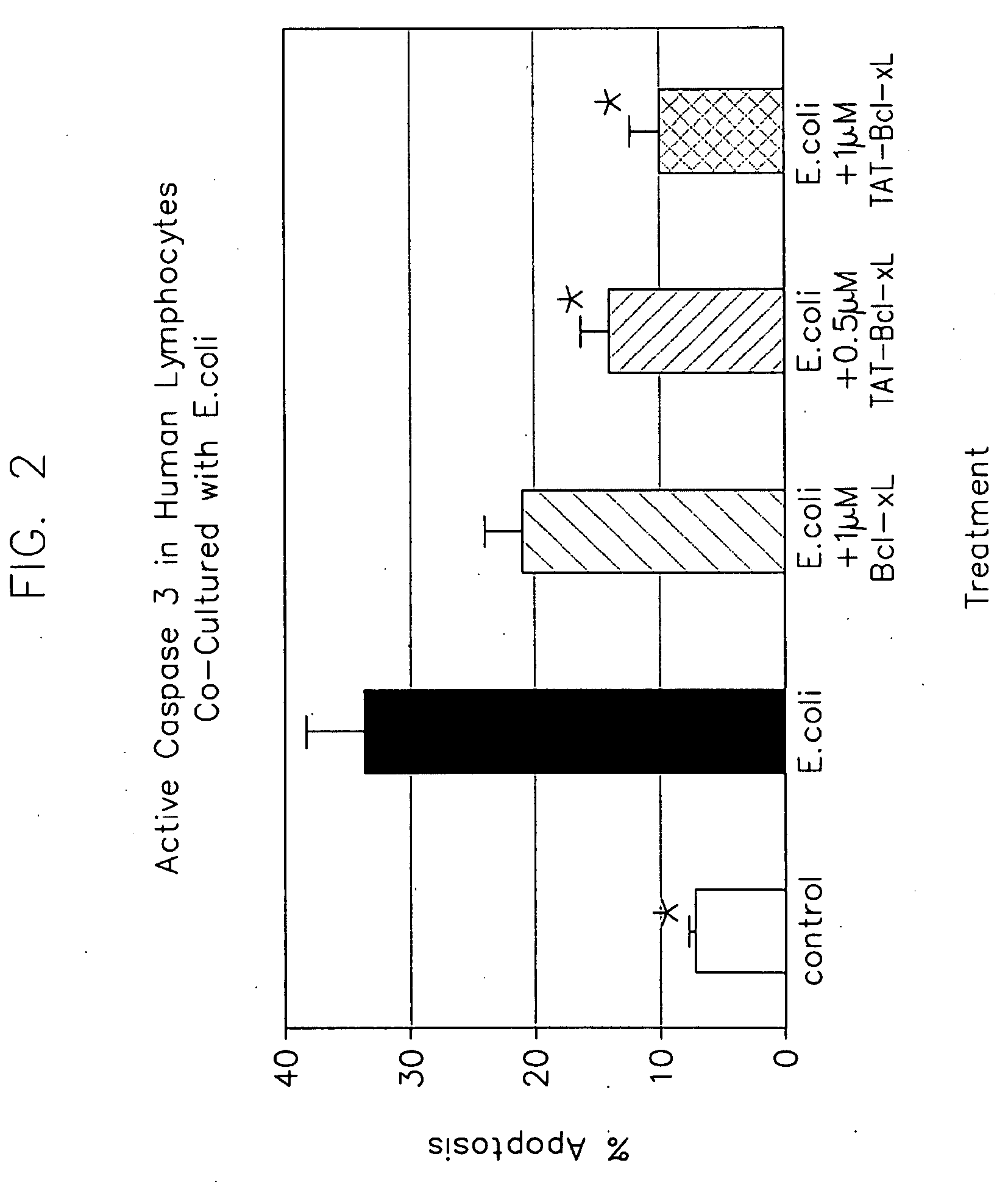Methods and Compositions for Treatment of Sepsis
a technology for sepsis and compositions, applied in the field of medicine, can solve the problems of sepsis being a major and growing health problem, organ failure approaching a quarter million patients per year, and sepsis remains a difficult condition to treat, and achieve the effect of reducing the death of apoptotic cells
- Summary
- Abstract
- Description
- Claims
- Application Information
AI Technical Summary
Benefits of technology
Problems solved by technology
Method used
Image
Examples
example 1
[0108]This example sets forth cecal ligation and puncture (CLP) as a model system for sepsis.
[0109]Mice that selectively overexpress Bcl-xL in T lymphocytes using the lck-proximal promoter were backcrossed to C57BL6 / J (Jackson Laboratory) mice for >10 generations. Tail snips were used to verify presence of the transgene via PCR analysis.
[0110]C57BL6 / J male mice were housed for at least one week before manipulations. Mice were anesthetized with halothane and an abdominal incision was performed. The cecum was identified, ligated, and punctured with a #30 gauge needle. The abdomen was closed in two layers and 1 cc of 0.9% saline was administered subcutaneously.
[0111]The cecal ligation and puncture (CLP) model was used to induce intra-abdominal peritonitis. It has been shown that positive blood cultures for poly microbial organisms (aerobic and anaerobic) result from this model, but not from sham-operated mice. (Baker et al., 1983, Surgery, 94:331; Hotchkiss et al. 2000, Nat Immunol. 1:...
example 2
[0113]This example illustrates quantification of apoptosis
[0114]In these experiments, thymocytes and splenocytes were obtained from CLP and sham-treated mice ˜20 hours postoperatively. The APO-BRDU™ kit (Phoenix Flow Systems, San Diego, Calif.) was employed for flow cytometric quantitation of TUNEL. Antibodies to active caspase 3 (Cell Signaling—Catalog #9664) were used in the flow cytometry and / or TUNEL assay.
[0115]Lymphocyte B and CD3 T cells were identified using fluorescently labeled monoclonal antibodies directed against their respective CD surface markers (Pharmingen). Flow cytometric analysis (25,000-50,000 events / sample) was performed on FACscan (Becton Dickinson, San Jose, Calif.).
example 3
[0116]This example illustrates E. coli bacterial-induced lymphocyte apoptosis.
[0117]Lymphocytes were harvested from peripheral blood obtained from 6 health) volunteers using a ficol gradient separation technique. Approximately 1×106 lymphocytes were plated in individual transwell containers. E. coli bacteria (strain ATCC 25922), that had been grown overnight in trypticase soy broth were added to a separate compartment of the transwell chamber separated from direct contact with the lymphocytes by a 0.02 micron filter (25 μl of bacteria at 3×109 CFUs added to 1 ml volume.
[0118]Bcl-xL, TAT-Bcl-xL, TAT-BH4, or an inactive TAT-BH4(D)2 (d)-Ac-RKKRR-Orn-RRR-bAla-(1)-SNRELVVDFLSYKLSQKGYS-COOH (SEQ ID NO: 1) were placed in experimental wells within 20 minutes after addition of bacteria. The inactive TAT-BH4(D)2 was identical to TAT-BH4 except that two tyrosines essential for the anti-apoptotic activity of BH4 were replaced by aspartate to render it inactive, and had the sequence (d)-Ac-RKKRR...
PUM
| Property | Measurement | Unit |
|---|---|---|
| diameter | aaaaa | aaaaa |
| volume | aaaaa | aaaaa |
| volume | aaaaa | aaaaa |
Abstract
Description
Claims
Application Information
 Login to View More
Login to View More - R&D
- Intellectual Property
- Life Sciences
- Materials
- Tech Scout
- Unparalleled Data Quality
- Higher Quality Content
- 60% Fewer Hallucinations
Browse by: Latest US Patents, China's latest patents, Technical Efficacy Thesaurus, Application Domain, Technology Topic, Popular Technical Reports.
© 2025 PatSnap. All rights reserved.Legal|Privacy policy|Modern Slavery Act Transparency Statement|Sitemap|About US| Contact US: help@patsnap.com



